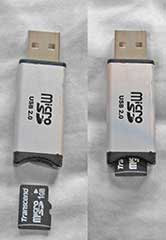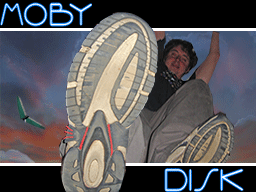R4/M3 Simply Setup
If you purchase an M3DS Simply (or the nearly identical R4DS) chip there is a lot you need to learn to set it up. This guide will save you a lot of effort.
Table of Contents
- Basics
- System
- Moonshell
- DSOrganize
- Customize bootup
- Understanding DLDI
- Homebrew
Basics
The M3DS Simply and the R4DS are slot-1 devices that use Micro-SD cards. These things are so friekin' tiny that:
- You should not have any ceiling fans on or windows open while using them, or they might blow away (true story)
- You will have no idea which way to insert them
- You will be afraid of breaking them
Insert the micro-sd card into the USB reader with the logos facing the same side. Insert the micro-sd card into the M3 with the logos facing opposite sides, so that the logo is facing the pins. The card fits into the M3 completely, but it sticks-out of the USB reader.


The rest of this tutorial assumes you are using Microsoft Windows, and that know how to copy files to/from your flash drive.
System
The first thing you need to do install the system files. These files allow the M3 to boot-up.
I recommend ignoring the CD that comes with it. It has Engrish
instructions and the software is probably already out of date. You should use the newer versions
from the web site.
Visit one of the web sites below, and download the most recent system files. Unzip the files and place them in the root directory of your flash card.
- Download the M3 system files (look for "Console software")
- Download the R4 system files (look for the "kernel" software)
Moonshell
Moonshell turns your DS into an mp3/video player and supports plug-ins for more stuff. It comes with a special tool for converting video files into a format appropriate for your DS.
- Download the latest version of MoonShell (You want moonshell171_with_dpgtools13.zip, or whatever is the latest)
Once you unzip moonshell you will see something like this:

You will want to plug-in your USB micro-SD reader at this point if it isn't already. After you unzip Moonshell, run the Setup.exe. It will ask you which drive has your flash card. We will look at the dpgtools folder shortly.

Deselect all of the ROM images except the R4TF. You do not want to select M3 since that is for the older M3 cards that use SD memory, not micr-SD memory. Click "Setup" and it will automatically copy the files to the flash drive. When the copy is complete, your flash card will have a moonshl directory and a file named MoonShell_R4TF_M3Simply-R4DS (MicroSD Card).nds. Notice that this works on R4 and M3 Simply devices. You can rename this file to Moonshell.nds if you prefer.

Moonshell also came with a directory called dpgtools. Inside that folder is dpgenc.exe which can convert video files (AVI, WMV, etc.) to the .DPG format that the DS can play. DPG is a variation of MPG that is modified to work with the limited processor capabilities of your DS. When you run dpgenc, the first thing you will need to do is set the language so you can read what's going on...

After that, just drag a video file onto the application. By default, the DPG file is placed on the desktop. Just copy the file onto your flash drive and you can play it using moonshell.

DSOrganize
DSOrganize is probably the most popular homebrew application. It turns your DS into a PDA with calendar, todo list, drawing pad, address book, and web browser. Like Moonshell, it also plays MP3s, displays pictures, and supports plug-ins. You still need Moonshell though, since it won't play videos.
- Download DSOrganize
- Download plug-ins for DSOrganize (I recommend the Genesis emulator and the bible plug-in)
You will want to get "DSOrganize 2.7 final" or whatever the latest version is. You will also want the "Custom exec_stub files" for the R4 and M3 Simply.
Unzip DSOrganize_2_7_Final.zip and es_r4m3.zip. Inside es_r4m3.zip is a file named exec_stub.bin. Copy this file into the DSOrganize\Resources directory, overwriting the file that is already there. This will allow you to run homebrew applications from DSOrganize. If you downloaded any plug-in files, place their .dsp files into the DSOrganize\Plugins directory. Finally, copy the entire DSOrganize folder and the DSOrganize.nds file to the root directory of your flash drive. It must be in the root directory. If you don't like this, you can mark the folder as hidden and DSOrganize will still find it. (Some cards, other than the M3 and R4 cards, may need the DSOrganize.ds.gba or DSOrganize.sc.nds files instead).
Customize bootup
Note: I have not done this on an R4 so I cannot say if the following works or not. If anyone has an R4, please let me know!
Customize boot screens
You can customize the image that appears at the top and bottom of the bootup screen. To do this you must create an image that is 256x192, and save it as a 24-bit BMP. To customize the top screen, the file must be named logo.bmp and placed into the _system_ directory. The bottom screen is icons.bmp.

Customize shortcuts
When you boot the system on an M3, you get 3 icons. The left icon opens a file browser, and lets you select an .NDS file to load. Program files (ROMs) are stored as either .NDS files or .DS.GBA. The middle icon runs _DS_MSHL.NDS. Whatever you want the middle icon to run, simply rename that file to _DS_MSHL.NDS. I think the designers of the M3 expected you to rename the Moonshell.nds file so that this icon runs Moonshell, but I prefer to rename the DSOrganize.nds file so that I can launch DSOrganize instead. Use whichever seems the best fit to your needs. The third icon runs whatever is in the GBA slot (slot-2).
Understanding DLDI
With the latest version of the system files for the R4 and M3 chips, DLDI patching is no longer necessary. You will (hopefully) not need to do this so you can skip this section. However, if a ROM can't seem to find its files, you may need to read this section.
Flash cards use FAT to store files. Different mod chips require different FAT drivers for accessing the flash memory. This driver is called the DLDI driver. Nintendo DS programs that need to read or write files to your flash card will need to be patched with the appropriate DLDI driver.
So far, we have not had to patch anything. Moonshell's install program automatically patched the ROM for you. DSOrganize knows how to patch itself on the fly. But some homebrew applications may need to be patched. To manually patch files, download the command-line tools listed below. If you go to Chihsm's web site, make sure you download the R4 driver, not the M3 driver, since the M3 drivers are for the Compact-Flash and SD versions of the card, not the micro-SD version.
- Download the DLDI patch tool or download the DLDI tools from Chishm's web site
- Download the DLDI patch file for R4 and M3
To run the DLDI tool, you need to specify the name of the DLDI patch file and the name of the ROM.

Homebrew
There are lots of homebrew games and tools available for the Nintendo DS. Here are some links to my favorites
More links coming soon...



